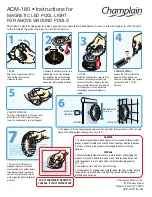
20
EN
MANUALE_SP3600_BWT-A5 - Rev: 01/2020
5.3. Transport.
Handle the product with care to avoid damages.
5.4. Handling.
Handle the product with care to avoid damages.
5.5. Positioning.
The product must be positioned under
head
(Fig. 9).
The product must be placed in an area not subject to
flooding (Fig. 4).
The product cannot be used on the water surface.
The product must always be located at least 3.5
[m] from the edge of the swimming
pool
from
which water is drawn (Fig. 10).
Considering the following aspects is recommended:
• Dimensions and position of hydraulic compo-
nents.
• Necessary clearance.
• Power cord position.
• Location of the power supply (electrical socket,
at least 3,5 [m] from the edge of the
pool
(Fig. 10)).
• Support and its location.
If the product is used with a
filter
, the latter must be
downstream from the product (Fig. 11).
If the product is placed outside it is advisable to put
a simple cover to protect it from rain.
Make sure the product is positioned in a place where
noise generated during normal operations does not
create disturbances.
The product must run in a horizontal position. Make
sure its position is not altered once it is correctly
placed (Fig. 12).
The product
must be fixed on a firm base, with
screws of 6 [mm] diameter, through the prepared
holes in the foot (Fig. 13, Fig. 14).
The product must be positioned in a shady and aer-
ated place.
5.6. Connections and start-up.
The electrical system must meet current inter-
national and/or national regulations.
The product must be connected to an power
outlet
equipped with a
residual current device
with sensitivity over 30 [mA]. Before starting the
product make sure this device is installed in your
electrical system. Contact a technician if necessary.
Make sure the product complies with your elec-
trical system.
The
power outlet
must be at a suitable distance
from the water but easily accessible in order to
be able to easily turn off the
product in the event of
fault (electrical socket, at least 3,5 [m] from the edge
of the
pool
). Cutting the power cord and/or replacing
the
power plug
is strictly prohibited.
The power cord must be positioned to avoid
possible damages such as bends and/or cuts
(Fig. 15).
5.6.1. Hose connection.
Proceed as follows:
1. Position the O-rings (Fig. 19, # 1, 3, 5) on the
rubber holder (Fig. 19, # 2 (Ø 32 [mm]), 4 (Ø 38
[mm])).
2. Screw the two rubber holders in (Fig. 19, # 2
(Ø 32 [mm]), 4 (Ø 38 [mm])) on the
inlet
and
outlet
side of the
pump
.
3. Apply some turns of the supplied teflon around
the rubber holders (
hydraulic parts
) to ensure
the pipe is sealed (
hydraulic parts
) onto the rub-
ber holder.
4. Connect the
inlet
pipe (hydraulic part) to the IN
rubber holder (Fig. 3) and the
outlet
pipe to the
OUT rubber holder (Fig. 3). Fix the pipes
(hydraulic part) with clips.
Check the hydraulic pipe is as short as possible to
minimize the decrease in
flowrate
. Avoid any defor-
mation or occlusion in the hydraulic pipes because
they might affect the
product operation.
Support the
inlet
and
outlet
pipes (
hydraulic parts
) of
the product in order to minimize the load on it.
5.6.2. Priming.
To make priming the product easier please follow the
procedure shown in Fig. 16.
Slowly fill the
product with clean water from the
in-
let
pipe, checking the
outlet
pipe fills with water too
(Fig. 16, OUT). Switch the product on only when all
the
hydraulic parts
are filled with water, inserting the
plug into the socket; the product shall bleed any air it
might still contain and start operation.
5.7. Reinstallation and reuse.
Clean the product and the moving parts accu-
rately before stopping the product for a while,
such as, for instance, during the winter months. Do
not lubricate and/or use detergents and chemical
cleaning products.
If there is the risk of freezing, the product must
be carefully emptied from the liquids in its hy
draulic circuit. It is advisable to empty all the
hydrau-
lic parts
.
5.8. Demolition and disposal.
Collecting recyclable material, both those used for
packaging (cardboard, nylon, etc.) and those re-
placed during maintenance is recommended. Suit-
able collection of waste material for recycling, pro-
cessing and environmentally compatible disposal
contributes in avoiding possible negative effects on
the environment and health and promotes the reuse
and/or recycling of product materials.
Illicit product disposal by the user may be pun-
ishable by current international and/or national
laws.
5.8.1. Electric/electronic waste disposal.
EU directive 2002/96/EC classifies this
product
as an electrical or electronic tool. The barred
bin symbol on the equipment or packaging in-
dicates that the product must be separated from
other waste at the end of its working life. Therefore,
the user must take equipment to electronic and elec-
tro-technical waste collection centres at the end of its
working life or return it to the dealer when purchasing
similar new equipment, on a one to one basis. Suit-
Содержание BWT SHOTT SP 3600
Страница 1: ...www bsvillage com MANUALE di MONTAGGIO Pompa per filtrazione SP 3600...
Страница 10: ......
















































